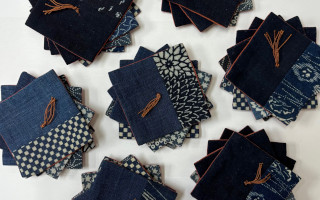
【KABUKI Miscellany】 Episode 10 : Narimono / Narrated by Tateo Okido
Hello! We are Asanoha, a tenugui specialty shop located in AzabuJuban, Tokyo.
We’re delighted to share a collection of intriguing stories related to Kabuki. These tales are narrated by Mr. Tateo Okido, an expert in Kabuki and the artist behind the original designs of our Kabuki-themed tenugui. Please enjoy this special series, Kabuki Miscellany, presented by Mr. Okido.
Kabuki Miscellany – Episode 10 : Shūmei (Name Succession)
In recent years, the kabuki world has seen a string of shūmei performances, and it feels as though name succession has become a formalized event. While each production has its own distinct character, the emphasis now seems less on the traditional heritage of performing arts and more on cultivating new stars to reinforce the public image of kabuki. Headlines tout first‑time four‑person successions, the revival of prestigious names after 81 years, debut performances by young siblings, and three‑generation simultaneous successions involving parent, child, and grandchild—all guaranteed to stir public fascination.
Yet many in the kabuki community may feel a sense of unease at this trend, as if the art form must rely on temporary celebrity creation to attract attention. In the old days, it was common that when a performer inherited a name, their artistry would deepen. The new name brought a resolve to master the inherited craft, an earnest commitment to live up to the reputation of previous masters. It was believed that the spirit of former greats would be reborn in the new holder. Audiences, too, viewed a name change as a rebirth; they hoped for the return of the greatness said to be associated with that name. Naturally, producers anticipated box‑office returns commensurate with the name’s prestige. This chain of expectations was a major element in the significance of shūmei performances.
Historically, such high‑profile successions have occurred before. For example, the family of one great actor announced a three‑generation succession—parent, child, grandchild—some years ago. Similarly, in another family, the names Mitsugorō, Minosuke, and Yaso‑suke were all succeeded at once back in the early 1960s. As for reviving long‑vacant prestigious names, in Showa 37 (1962) the name Danjūrō was revived after 60 years in the Ichikawa lineage; and in 2005, the grand name Sakata Tōjūrō was revived after 231 years in Kamigata kabuki—among many such landmark events that stirred excitement in their generations.
But those revivals were seldom superficial. They occurred only when the performer’s skill, the producer’s support, peers’ backing, and audience expectation all aligned — a true coming‑of‑age in readiness.
In recent times, very few actors focus solely on refining traditional kabuki, staying within the world of classical stage art. More often, they branch out into film, television, or other performance genres to broaden their fan base and gain diverse experience. While this can be beneficial for their artistic growth, fame achieved through mass media exposure runs the risk of cultivating only superficial celebrity — which may, in turn, choke the growth of their kabuki artistry.
For kabuki to thrive, what matters is not just recognition, but deep commitment: actors who, inheriting a name, patiently cultivate roles aligned with their own spirit while honoring the legacy. They must undergo the training, accept the discipline, and steadily build a body of work that allows audiences to trust and enjoy classical kabuki without reservation.
In our modern age — where stage art competes with a flood of entertainment and each performance vies to be an “event” — the essence of shūmei must remain grounded in tradition.
During a shūmei ceremony, while other actors wear simple robes or yukata for rehearsal, the naming actor dons formal montsuki hakama — a symbolic gesture of bearing the weight of a name. This solemnity is the very heart of traditional kabuki. I hope that the actors themselves, with firm conviction and humility, reflect deeply on the significance of name succession, nurture their own artistic realm, and carry forward the true spirit of this venerable art form.
At Asanoha, we offer a wide selection of tenugui featuring kabuki-related designs. One such piece, connected to this episode of Kabuki Miscellany, is titled “Shūmei Hiro” (Name Succession)—based on original artwork by Chihō Kari
Tenugui : Shumei Hiro (Name Succession Ceremony)



